
August 2017
As I thought about how to address this issue, I realized that I have a difficult problem to overcome. I think I can safely assume that very few of you have participated in a Masonic ritual, and that not all of you have been inside of an LDS temple. Furthermore, we want to be respectful of both organizations and stay within the bounds of what is appropriate to talk about in public.
To help you understand the relationship between LDS temple ceremonies and masonic rituals, I need to give some background. I should also clarify that I am not a Freemason, so I will have to thank Master Masons Greg Kearney and Ned Scarisbrick for their input.

Freemasonry has been around a long time. You can trace it origins back to medieval stone masons guilds of the middle ages. The first reference to freemasonry goes back to York England in 975.[1] But the operative stone masons guilds started to collapse with the changing economy in the late 1600’s[2] and they started to open up their membership to others who didn’t directly practice the craft. But, the explosion of information on modern Freemasonry really started when the grand lodge was formed in London in 1717[3]. Since that time, over fifty thousand books, pamphlets, and articles have been written on the subject.[4] There is so much written on it, and such a variety of opinions, it would be impossible to cover it all in the time I have. But, I’m going to try to get a few main points across.

Freemasonry is one of the world’s oldest and largest non-religious, non-political, fraternal and charitable organizations. It has about 4 million members worldwide. Its members are expected to be of high moral standing and are encouraged to speak openly about their membership in Freemasonry.[5] Only men are allowed to be Masons, and they meet together in a group known as a “lodge.”

The organization teaches moral and social virtues through participation in a series of ritual dramas. These dramas are a progression of plays which are memorized and performed within each Lodge. They use stone Masons’ customs and tools as allegorical guides, and are believed by many to follow ancient rituals.
The ceremonies demand a high degree of personal involvement. For example, one of the ceremonies dramatizes the murder of a man named Hyrum Abiff, who is claimed to be the architect for Solomon’s temple. The basis of this story comes from 1 Kings Chapter 7 which talks about Hiram of Tyre, a widow’s son of the tribe of Naphtali. In 1 Kings we read that he is tasked to make many of the features of Solomon’s temple, including the basin with the 12 oxen. In this dramatization, if you were the initiate, you would be playing the part of Hyrum Abiff in a dramatic play.
The Freemasons use this active participation to reinforce learning of the moral and social virtues. They literally put you in the play to teach you what they want you to learn and remember.
My father was a very successful biology teacher. He involved his students in a play to act out how DNA replicates. One day we got a phone call at our home from one of his former students who was attending Yale University. He excitedly related how he just passed his biology test by remembering what happened during that play.
Freemasonry instills in its members a moral and ethical approach to life: its values are based on integrity, kindness, honesty and fairness. Freemasonry teaches concern for all people, care for the less fortunate and help for those in need.
They have traditionally cared for widows and orphans and engaged in acts of charity. These activities were very important historically as government aid for the poor did not exist until fairly recently. Mozart’s widow is one of the most famous to receive such charity.[6]
 In modern times they still participate in many acts of charity such as funding for children’s hospitals.
In modern times they still participate in many acts of charity such as funding for children’s hospitals.
Freemasonry is not a religion, however. Masons make no claims to helping people obtain salvation. They accept members of every faith, the only requirement being a belief in God as no atheist can be made a Mason.
Freemasons are supporters of law and order, and have members who are considered to be people of high standing in the community. Notable Masons include several of the founding fathers of the United States, such as George Washington and Benjamin Franklin.

Many of the ideas of equal rights, elections, swearing on a bible, and majority rule found in constitutions of many countries, can be traced back to Masonic beliefs and practices.[7]
*Other famous Freemasons include nobility of Great Britain, the German Emperors William I and Frederick III, as well as nobility and government leaders of many European countries.
So with that short description of this altruistic and law-abiding group, why would anyone think there is a problem? Why are people concerned about the Freemasons, and how does that relate to Mormonism?
The first problem some people have with Freemasonry is the insistence on secrecy. Even Joseph Smith commented “The secret of Masonry is to keep a secret.”[8] While Freemasons are open about who belongs to their group, they make promises not to reveal the ceremonies that occur within their lodge.
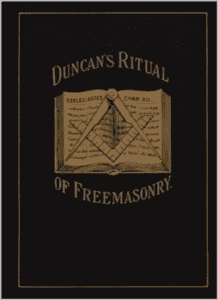 You can read many of the rituals yourself in books you can find in Masonic libraries such as the 1866 Duncan’s Ritual of Freemasonry, but Masons believe that lessons learned through the rituals are best understood when personally experienced, so they don’t talk very specifically about them. Talking about them ruins plot twists in their plays. They don’t like spoilers.
You can read many of the rituals yourself in books you can find in Masonic libraries such as the 1866 Duncan’s Ritual of Freemasonry, but Masons believe that lessons learned through the rituals are best understood when personally experienced, so they don’t talk very specifically about them. Talking about them ruins plot twists in their plays. They don’t like spoilers.
The Masons have instances in their ceremonies where they remind the initiates about the importance of secrecy. These have historically been given with a description of what terrible thing you would rather have done to you than to reveal the rituals contained within Freemasonry. I remember as a child making promises of secrecy where we would recite the words, “Cross my heart and hope to die, stick a needle in my eye.” This gruesome child’s rhyme is very similar to the type of oaths within historic Masonry as well as historic LDS temple ceremonies. Many opponents of Masonry and Mormonism, however, have claimed that these oaths are not oaths of secrecy, but oaths of vengeance and calls for violence. They are not. Or at least, they are not intended to be such.
The second problem some people have with Freemasonry is its relationship with religion. Remember, there is no promise or expectation of salvation in Freemasonry and it is not a religion. They accept members of all faiths and encourage their members to attend the church of their choice. Many argue that Masonry developed as a secular way to deal with things in a hyper religious era. But, with an emphasis on morality and belief in God, some have argued that Masonry is a pseudo-religion and since it does not include Christ it must be an evil substitute.
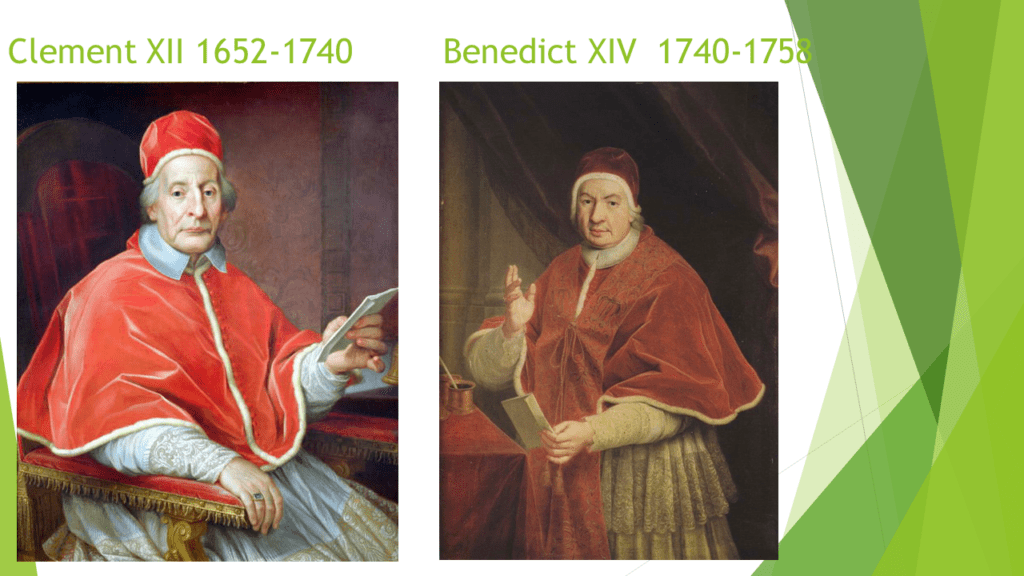
The Catholic Church has historically had a particularly antagonistic relationship with Masonry. In the Eighteenth century, there were condemnations by Pope Clement XII in 1738 and Pope Benedict XIV in 1751. In addition there was a condemnation given by Cardinal Giuseppe Firrao, Secretary of State for the Papal States, in 1739.[9] Those condemnations cited the secrecy with which the Masons surrounded themselves, the oaths they swear, and suspicion of acting against the peace and good order of society.[10] It is probable that the Pope also suspected them of heresy due to their meetings where both Catholics and non-Catholics met together regularly, which at the time was frowned upon and could lead to possible church discipline.[11]
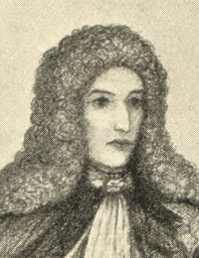
He was an English knight who moved to France and tried to get people involved in Freemasonry. The French didn’t seem interested in a group that focused around the work of stonecutters, so in 1738 Ramsey made a famous speech outlining a new and provocative history for Masonry. We don’t know if Ramsey was sharing the truth, his personal beliefs, or a story of fiction.
He put forward the claim that Masonry wasn’t born of stonecutters in Scotland, but instead came from ancient origins through the Crusaders to the Holy Land, that had made vows to restore the temple to the Christians.[12] Suddenly there was a great flurry of interest in Freemasonry. It was alleged at that time, and many believe today, that the Knights Templar, many of whom had been imprisoned and excommunicated from the Catholic Church on Friday the 13th, 1307, had found sanctuary among the Masons in Scotland. It was further alleged that they had shared the secrets of the temple mount with the Masons. This narrative creates the tie the Masons have with the Knights Templar that we often see in books and movies today.
Allegedly, the Masons also offered sanctuary to some early protestant reformers, which certainly would not have made the Catholic Church happy.
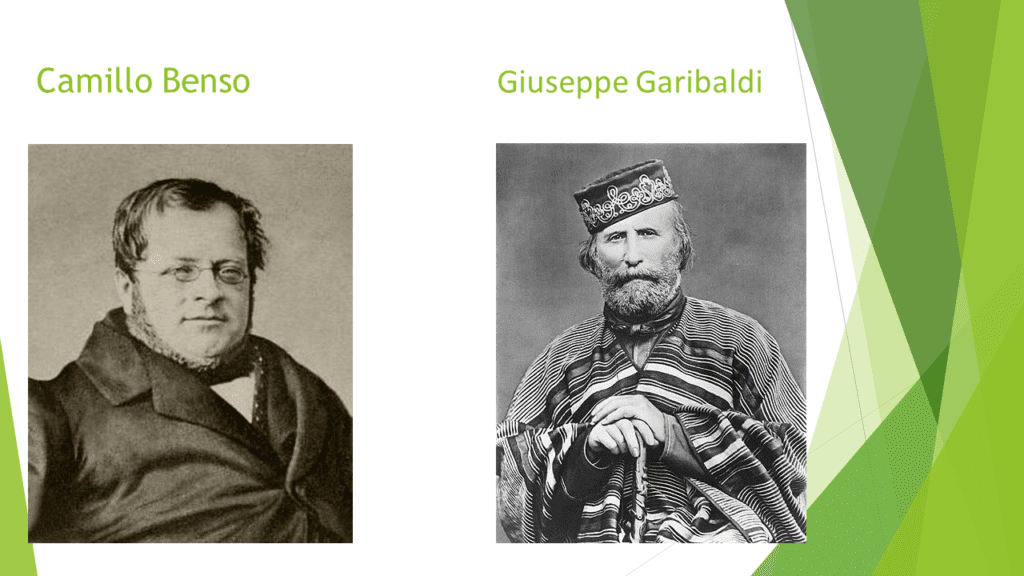
In Italy, in the late 1800s, there was a nationalist movement which sought to take the secular power from the Catholic Church. Two of the leaders of the Nationalist movement, Camillo Benso, the Count of Cavour and Giuseppe Garibaldi, were both Freemasons, so that Pope also put out a string of Papal Bulls condemning Masonry in the hopes of weakening those two men and retaining the Catholic Church’s secular power in Italy.[13]
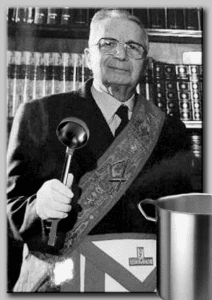
From these examples, we can see why there might be a historical antagonism between Masons and Catholics.
Among Protestants there is a mixed view on Masonry. The anti-Masonic rhetoric comes from the fundamentalist evangelical Christians who believe that Freemasonry should be regarded as an “evil organization devoted to the occult.” This criticism started in the 1800s and continues to this day.[15]
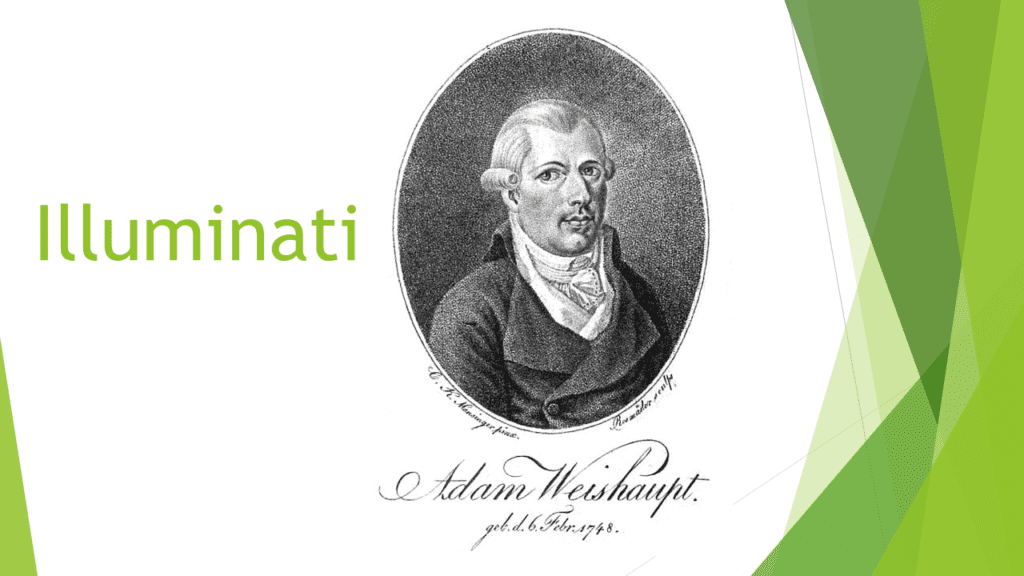
We have to turn our attention to the German-speaking countries where there were problems with a non-Masonic group in Bavaria that many people confuse with the Masons. This group was known as the Illuminati. In 1776, Adam Weishaupt, the dean of the law faculty at the University of Ingolstadt, established the “Order of the Illuminati” and constructed a legendary history that traced the organization’s origins to Persia a thousand years earlier. By saying “Constructed a legendary history,” I mean he made up the story. Unlike Masonry, which tries to remain non-political, Weishaupt liked the political revolution that was going on in America and planned to utilize this new organization to overthrow the Kingdom of Bavaria and replace the monarchy with a form of republican government. A year later, Weishaupt was initiated as a Freemason in Munich and used that masonic relationship to recruit heavily among the Masons for followers to join the Illuminati. In 1784, eight years after their founding, the group was discovered and banned from Bavaria along with the Masons. The aggressive measures taken by the police destroyed the order, but rumors continued to persist. Since that time, the Order of the Illuminati have become the favorite bad guys in modern novels and movies and a staple among conspiracy theorists. Just think, if things had gone differently with the US revolution, the US founding fathers could have been the equivalent of the Illuminati in movies and books today. The important things to remember are they were never a Masonic lodge, and they were not what is portrayed in movies today.
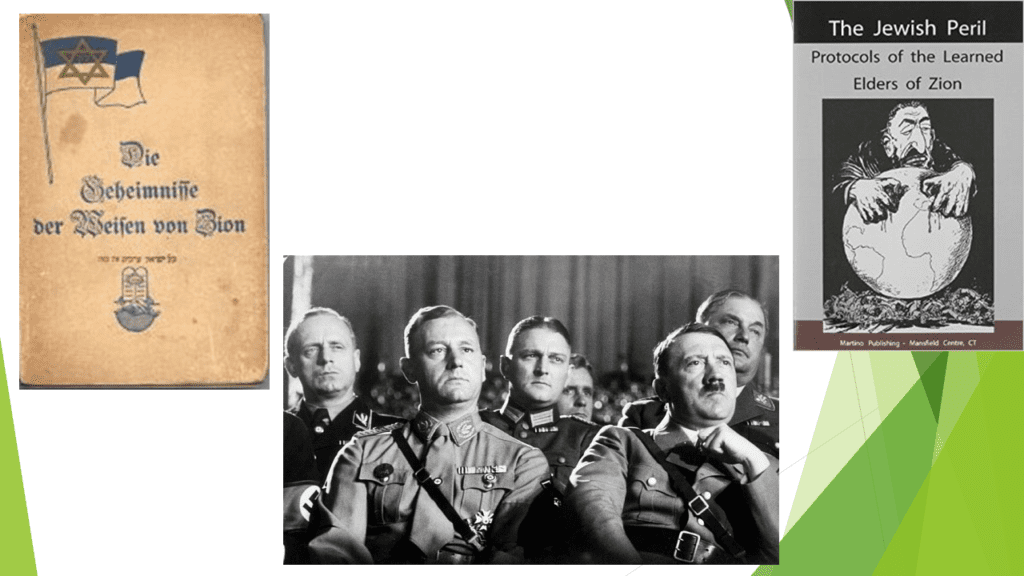
In more modern times the Nazis, under Adolf Hitler, using an 1897 book titled “The Protocols of the Elders of Zion,” taught that the Jews secretly controlled the Masons and that the two groups together were working toward world domination.[16] Anti-Semitism became closely tied to anti-Masonry. The irony of this is that there were very few Jews involved in Masonry at that time. The Freemasons were mostly Christians. The anti-Semitic and anti-Masonic “Protocols of the Elders of Zion” book was actually a forgery put together by the Russian secret police.[17] Nonetheless it became a central part of Nazi propaganda and is still read in many countries today. When cities were captured, within 24 hours Nazis would burst into the Masonic lodges, gather up all of the books and records and send them to Berlin.[18] The Nazis were hoping to learn the ancient mysteries of the Temple they believed the Masons were hiding from the world. When the Russian military invaded Germany, they captured the libraries and sent them back to Moscow. The libraries were not returned until the year 2000.[19] Scholars have looked at the books since that time and no great secrets of the Temple or scandals have been discovered.
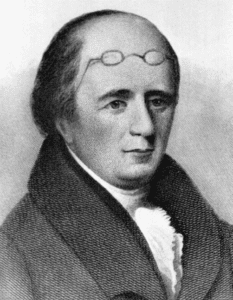
W. W. Phelps was a member of that party. He edited a newspaper called the Lake Light, and then published the Ontario Phoenix, both anti-Masonic newspapers.[21] He later joined the LDS Church, becoming a scribe for Joseph Smith an editor of The Evening and the Morning Star, and the Times and Seasons as well as having various important Church callings.[22]
The widow of Mr. Morgan, Lucinda Morgan, later Lucinda Morgan Harris, also joined the Church and some believe she was sealed to Joseph Smith, although the evidence of this is uncertain.[23]
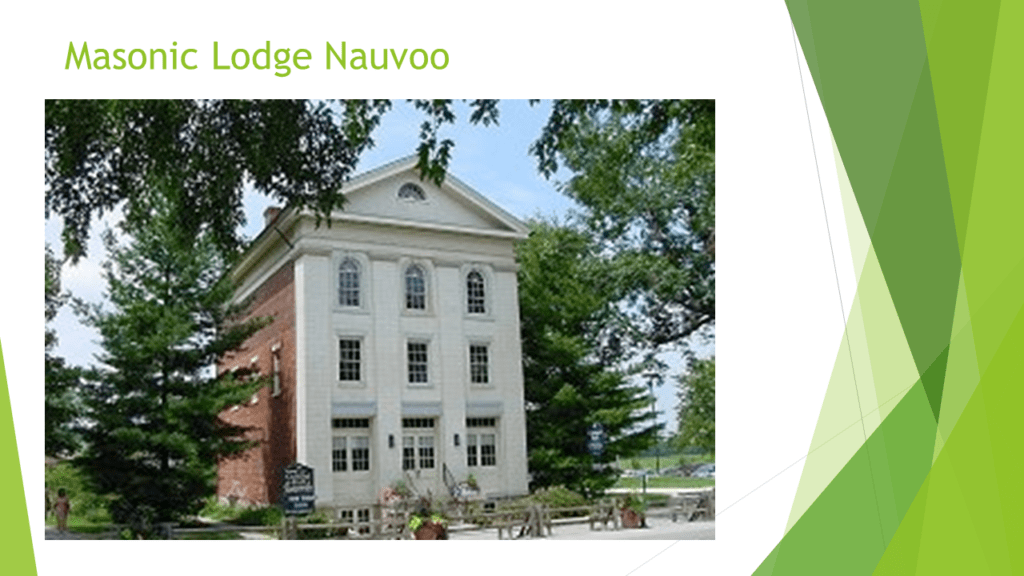
That brings us to the connection with the story of the Mormons. The Saints had suffered much at the hands of the mobs of Far West, Missouri. They escaped back east across the Mississippi river to Illinois where they built the city of Nauvoo. Joseph Smith was looking for a way to protect the members of the Church from their antagonistic non-Mormon neighbors, and he became interested in Freemasonry. As part of their ceremony, the Masons take an oath to protect and care for each other. It seemed the perfect solution. The Saints would become Freemasons and fall under the protection of their Masonic non-Mormon neighbors, while at the same time learning the ancient rituals of Masonry, which at the time were believed to date back to the time of Solomon. Apostle John Widtsoe later wrote that Joseph Smith was initiated into the Masons to foster “the spirit of brotherhood” and to “lessen the mob persecutions to which the Church had been subjected in Ohio and Missouri.” Ultimately, Joseph’s “attempt to win sufficient friends through Masonry to stop persecution failed.” It is alleged that Joseph gave the Masonic cry of distress during his martyrdom, and yet his non-Mormon Masonic brothers did nothing to help. Some were likely among the murderers. This made Brigham Young later say, in reference to those Illinois Masons, that “Joseph & Hyrum were… put to death by masons…”[24] The Warsaw Lodge, which invited some of those men to participate in the lodge even after they had been indicted for the murders of Joseph and Hyrum, temporarily lost their charter for not following Masonic rules and standards.[25]
At this point many LDS members question how Joseph Smith and the Nauvoo Mormons could join the Masons when the Book of Mormon clearly states that secret combinations are of the devil. Masons keep their ceremonies secret, so therefore they must be a secret combination, right? Even Martin Harris, who was an anti-Mason himself, advertised the Book of Mormon as a new “anti-masonick [sic] Bible.”[26]
One of our Sunday School guides, “The Guide to the Scriptures,” defines secret combinations as “an organization of people bound together by oaths to carry out the evil purposes of the group.”[27]
In 2Nephi 9:9, speaking of the devil it says that he “stirreth up the children of men unto secret combinations of murder and all manner of secret works of darkness.”
In General Conference Elder Melvin J. Ballard said:
The Book of Mormon teaches that secret combinations engaged in crime present a serious challenge, not just to individuals and families but to entire civilizations. Among today’s secret combinations are gangs, drug cartels, and organized crime families. The secret combinations of our day function much like the Gadianton robbers of the Book of Mormon times. They have secret signs and code words. They participate in secret rites and initiation ceremonies. Among their purposes are to “murder, and plunder, and steal, and commit whoredoms and all manner of wickedness, contrary to the laws of their country and also the laws of their God.” [28]
If we compare these prophetic warnings with the Freemasons, they really don’t fit the definition of secret combinations. Freemasons as a group do not plan murders. They plan how to fund hospitals. Freemasons do not plan the overthrow of governments. That would be groups like the Illuminati. Freemasons don’t plunder, steal and commit whoredoms, they in fact teach against those things and expel members who engage in those activities.
So on December 29, 1841, the Nauvoo Masonic Lodge was organized. On March 15, 1842, Joseph Smith was initiated as an apprentice and then was raised to the level of Master Mason.
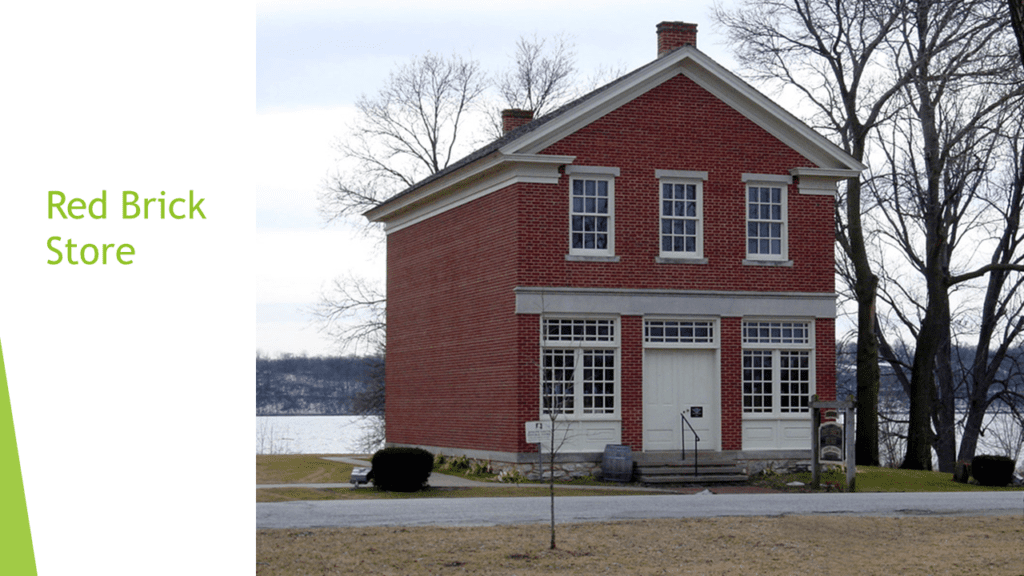
On May 4, 4 months later, Joseph introduced the new endowment to nine men on the second floor of the red brick store in Nauvoo. He had the second floor prepared for the event by having canvases hung, partitioning off the second floor space into 5 rooms representing creation, the garden of Eden, the earth after Adam and Eve’s expulsion, the present-day world, and the celestial room.[29] Nine of Joseph’s closest followers were first given their endowments here.
*At the conclusion of the endowment, Joseph told Brigham Young, “[T]his is not arranged right but we have done the best we could under the circumstances in which we are placed, and I wish you to take this matter in hand and organize and systematize all these ceremonies with the signs, tokens, penalties, and key words.” Brigham commented, “I did so, and each time I got something more, so that when we went through the temple at Nauvoo I understood and knew how to place them there. We had our ceremonies pretty correct.”[30]
So, if Joseph created the temple endowment ceremonies after becoming a Mason, did he just copy the ideas presented in the ceremonies from Freemasonry?
To address that, let’s first talk about what goes on inside an LDS Temple to the extent that it is appropriate in this setting.
The first and most familiar ordinance in the temple is baptism for the dead.
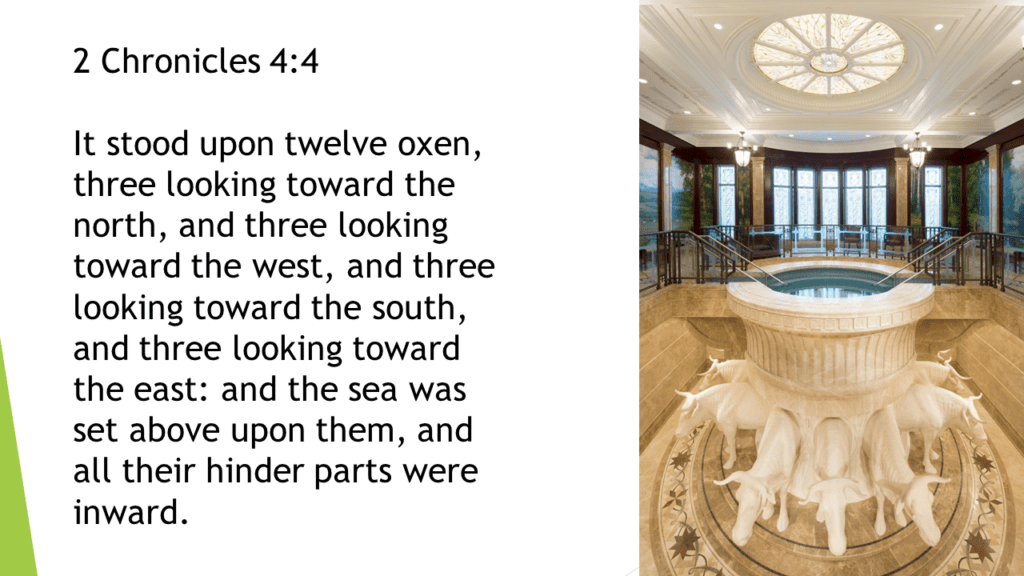
Baptisms are performed in a font that rests on the back of twelve oxen. The font is modeled after the basin described in Solomon’s temple in 2 Chronicles 4:4.
It stood upon twelve oxen, three looking toward the north, and three looking toward the west, and three looking toward the south, and three looking toward the east: and the sea was set above upon them, and all their hinder parts were inward.
After baptism, we confirm those baptized as members of the Church.

The second ceremony in the temple is the washing and anointing ceremony where one is symbolically washed and anointed. This is as recorded in the book of Exodus, Chapter 40, verses 12 and 13 where it says,
12 And thou shalt bring Aaron and his sons unto the door of the tabernacle of the congregation, and wash them with water.
13 And thou shalt put upon Aaron the holy garments, and anoint him, and sanctify him; that he may minister unto me in the priest’s office
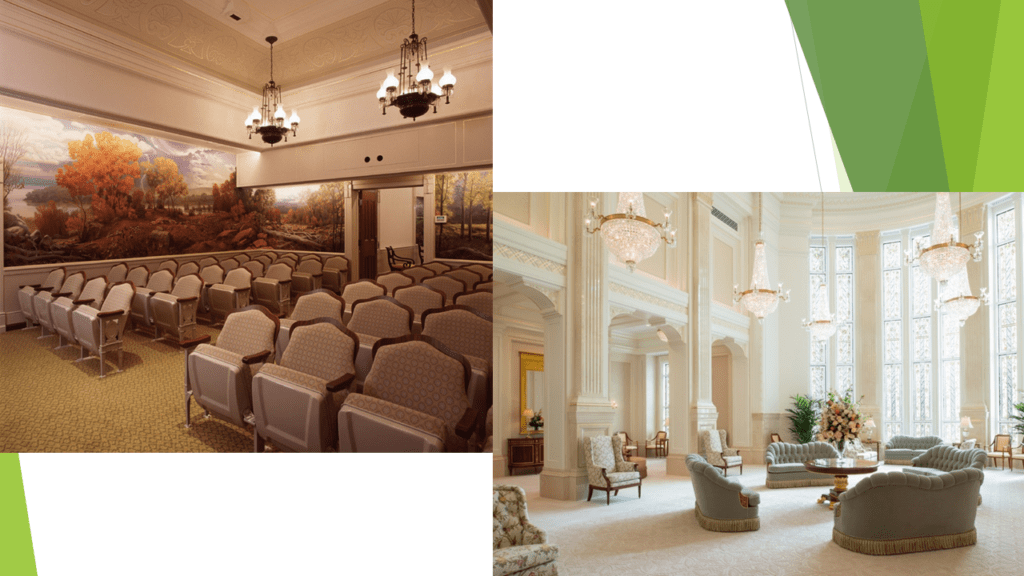
Third, there is an endowment ceremony where, through dramatization, one symbolically falls from the presence of God, makes covenants to follow God and Jesus Christ, and, eventually, returns back to the presence of God.

Fourth, there is a sealing or marriage ceremony where couples are sealed to each other and where parents and children are sealed to one another as families for time and all eternity.
 How does this compare to Freemasonry? In Freemasonry, there is no baptism. In Freemasonry there is no confirmation. In Freemasonry, there is no washing and anointing, except perhaps in one very obscure rite that is unlikely to have been familiar to Joseph Smith. In Freemasonry there is no sealing. Only men are allowed in ceremonies, so the whole idea of sealings between men and women would be completely foreign.[31] In Freemasonry there is no concept of work for the dead. In Freemasonry there are no ordinances that relate to salvation through Jesus Christ. In Freemasonry things are done democratically and your relationship with your fellow man is taught, while in LDS temples all judgments and covenants are with God. Most of what is taught in the temple is not Masonic. The Gestalt, or entire concept is different.
How does this compare to Freemasonry? In Freemasonry, there is no baptism. In Freemasonry there is no confirmation. In Freemasonry, there is no washing and anointing, except perhaps in one very obscure rite that is unlikely to have been familiar to Joseph Smith. In Freemasonry there is no sealing. Only men are allowed in ceremonies, so the whole idea of sealings between men and women would be completely foreign.[31] In Freemasonry there is no concept of work for the dead. In Freemasonry there are no ordinances that relate to salvation through Jesus Christ. In Freemasonry things are done democratically and your relationship with your fellow man is taught, while in LDS temples all judgments and covenants are with God. Most of what is taught in the temple is not Masonic. The Gestalt, or entire concept is different.
There are, however, a few similarities that create the questions. I will go over them later.
Many of the early saints who went through the Nauvoo temple endowment were already Freemasons. These included Brigham Young, Willard Richards, William Marks, Hyrum Smith, and Heber C. Kimball. They seemed to believe that Freemasonry was an apostate form of temple worship from Solomon’s temple. Just as they had no problem with Joseph receiving revelation on apostate practices in Christianity, they had no problem with Joseph receiving revelation on how the temple ceremony should be carried out. They didn’t seem to believe the temple ceremony was simply a Masonic ceremony.
W. W. Phelps and Lucinda Morgan Harris, both avid anti-Masons—Lucinda having had her first husband allegedly killed over Masonry—had no problems being endowed in the Nauvoo temple. They clearly didn’t believe the temple ceremony was a Masonic ceremony.
After the temple ceremonies were performed in Nauvoo, the Masonic lodge continued to operate.[32] So clearly the other Church members who were Masons also didn’t feel that the temple replaced Masonry.
Even anti-Mormon writer Fanny Stenhouse wrote, “It has always been commonly reported, and to a great extent believed, that the mysteries of the Endowment House were only a sort of initiation… of the rites of Masonry; but I need hardly say that this statement when examined by the light of facts, is altogether ungrounded and absurd.”[33]
So if knowledgeable Mormons and Mormon critics have indicated that the Mormon temple ceremony is not the Masonic ceremony, why does the question of a connection still exist?
It exists because there are a few similarities between masonic rituals and a few of the phrases and actions used in the endowment ceremony. It is only with the endowment ceremony there is confusion. There is no confusion relative to the other temple ceremonies such as baptism and sealing which are not masonic in nature. Additionally, there are some masonic-like symbols related to temples.
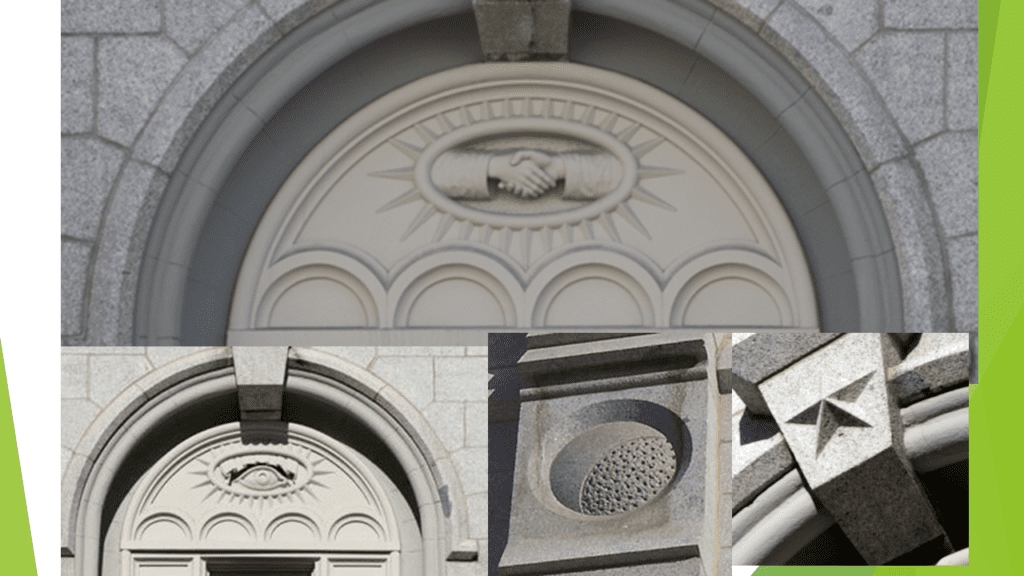
So let’s deal with those similarities, beginning with the symbols on the Salt Lake Temple. Before the Salt Lake Temple was built, Brigham Young sent architects all over Europe to look at many of the great cathedrals. It is likely they got many of their design and symbol ideas from those structures. We can see that the symbols related to temples and temple architecture have deep roots in Western Christian culture. On several structures in Europe, you can find handshakes, stars, pentagrams, and the all-seeing eye. Here are a few pictures of the all seeing eye from several different churches.
This first one is from the Capuchin Crypt in Rome.
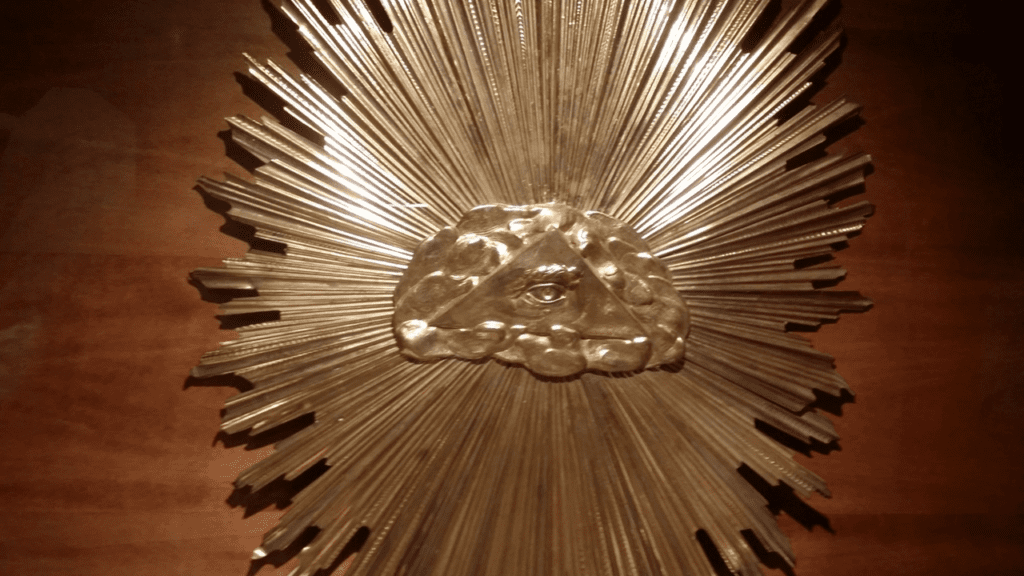
These next few pictures are from various churches in Vienna Austria. I have also seen these in the Czech Republic and a YSA group from Sicily told me the symbol was common in their local churches.
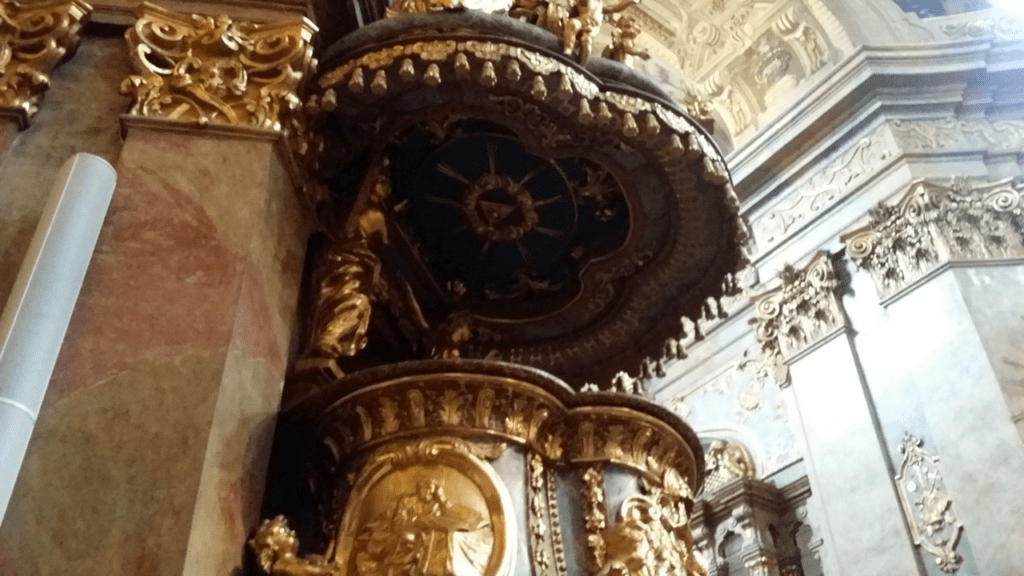
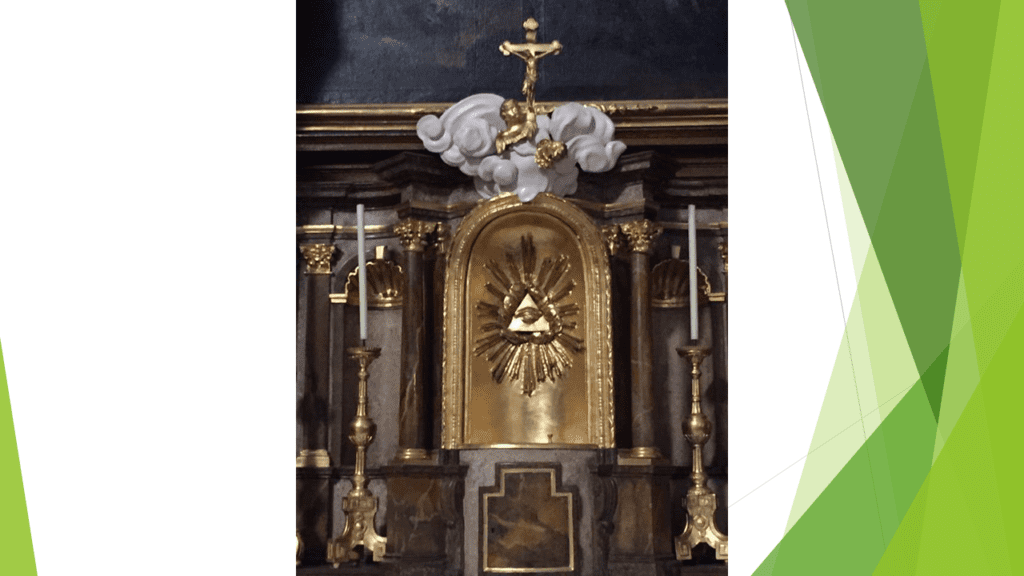

This reinforces what Master Mason Greg Kearney stated to me that it is his believe that many symbols in freemasonry predate the modern masonic lodge.[34] You will also see this symbol on US currency. One large anti-Mormon website claims the phrase “Holiness to the Lord” that is on our temples has been copied from the Masons because it often appears in the wall of the lodge. But, it occurs several times in the Bible, usually in conjunction with ancient temples. There are other symbols within temples and within masonry, but we don’t have the time to go through each item.
Now let’s talk about the ceremonial similarities. The endowment ceremony is presented as a ritualistic drama. Masonic ceremonies are also ritualistic dramas, so in that general form, they are similar, even though they are totally different dramas. The endowment ceremony starts with the creation and the Garden of Eden, and moves us progressively through our return to God’s presence, while the Master Mason drama story line focuses on the murder of the master builder of Solomon’s temple and is designed to teach character and integrity. There are some critics who say there was one Masonic group in France that used the Garden of Eden in their rituals, but that was a renegade group that created a women’s ritual using the Garden of Eden. Of course, women can’t be masons, so it was not authorized. The group only existed for a few years, so it is highly doubtful Joseph was even aware of those rituals. In any case, there are other sources for the Garden of Eden story—like the Bible and the Pearl of Great Price—other than a small group of women meeting in a secret lodge in France.
There are some short word phrases and actions used in the temple ceremony that are similar to word phrases and actions used in masonry, but the masonic word phrases and actions are not related to the themes, teachings, or covenants made in the temple. Even those places where actions are similar, they have completely different meanings. Joseph seems to have taken some of the actions and completely repurposed them. It is also interesting to note that the similar short phrases that are currently used are not critical phrases in the endowment ceremony. When the endowment ceremony was first performed in Nauvoo, it was much longer. As it has been shortened over the years, the Masonic-like phrases have been almost entirely removed.[35]
At this point we have to stop and talk about the nature of revelation. Brigham Young said “When God speaks to the people, he does it in a manner to suit their circumstances and capacities. …Should the Lord Almighty send an angel to rewrite the Bible, it would in many places be very different from what it now is. And I will even venture to say that if the Book of Mormon were now to be rewritten, in many instances it would materially differ from the present translation.”[36]
Revelation comes from God, but comes through men. Too often we think that whatever comes out of the mouth of an apostle or prophet must be exactly what God said, word for word. But, if that were true, we wouldn’t have so many wonderful airplane analogies coming out in General Conference. Our language becomes filtered by our experience. Joseph Smith, Brigham Young and many members of the Church in Nauvoo were familiar with the language of Masonry. So one would be very surprised if it didn’t crop up in their writings and teachings.
Catholic scholar Massimo Introvigene writes “Anti-Mormons … often read too much into [similarities between the endowment and Masonic ritual].” He goes on to say, “Smith had used the Masonic language of the rituals for the purpose of confirming his followers familiar with Freemasonry into a doctrine which had no ‘similarities’ with anything they had heard in the masonic lodges.”[37]
Masonic rites confer a series of “degrees” upon individuals. The three basic degrees are Entered Apprentice, Fellow Craft, and Master Mason. Each of these degrees has its own ceremony and are together known as the “Blue Lodge.”[38] As the initiate makes promises he shakes hands or performs other physical movements to signify his agreement.
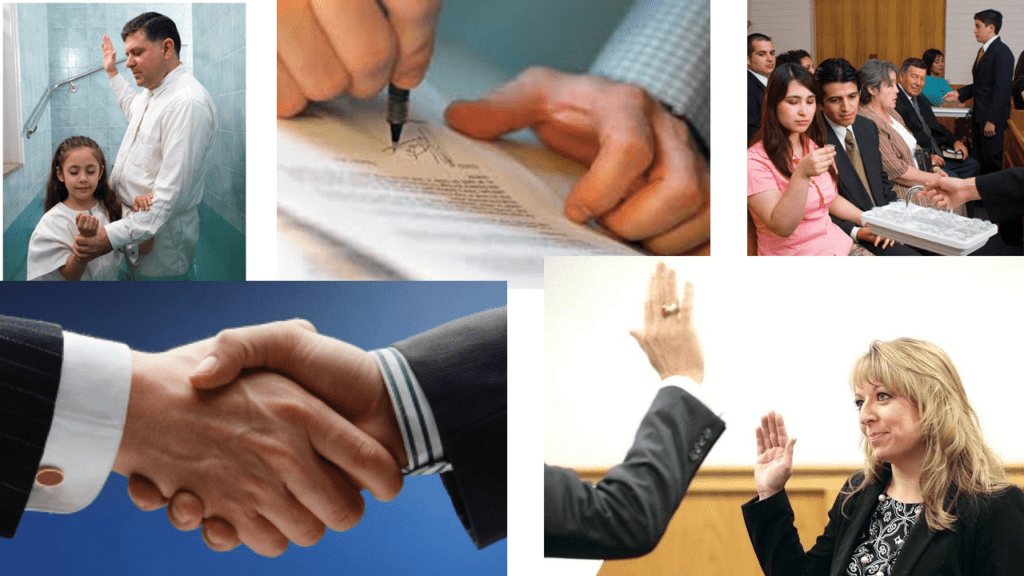
If you think about it, there are a number of ways in our culture to represent making promises or covenants including signing our name on paper, shaking hands with another person, raising our right hand to the square, being immersed in water, eating bread and water or wine, or even the American TV cowboy custom of spitting on your hand and then shaking hands. All of these are tokens of the promises we are making.
Through time, God has also used various methods, or signs, to represent the making of covenants. In Genesis 17:11, talking about circumcision it says, “And it shall be a token of the covenant betwixt me and you.” In Genesis 9: 12, God talks about the rainbow and says, “This is the token of the covenant which I make between me and you.” In Exodus 12: 13 when the blood is put on the door posts, God says, “And the blood shall be to you for a token.” In the Book of Mormon, when Captain Moroni asks for people to follow God in Alma 46:21 the people rent their garments “in token, or as a covenant, that they would not forsake the Lord their God.”
So a token is a physical action that God asks us to do as we make promises. Remember, we make tokens of promises every day as we sign our names to important documents—even documents that may seem trivial, such as the pieces of paper in your checkbook. Signing our name is a physical action to represent the promises we are making. In 2 Kings, Naaman was asked to wash himself seven times in the river Jordan to be cured of his leprosy. We all know that the water in the river Jordan did not cure his leprosy, but rather it was Naaman’s willingness to humble himself before God that paved the way for God to cure him.
Whatever the physical action is that we do, the important thing is the covenant or promise we make and not how we symbolize that promise. It is important to note however, that the Lord has mandated to us certain ways to represent certain covenants just as he mandated to Naaman to wash seven times in the river. So we should not discount the divine source for those tokens.
There are other optional degrees in Masonry which are organized into two groups, the York Rite and the Scottish Rite. One of the ceremonies in the York Rite is called the Royal Arch Degree, and it has been singled out as a possible source for the Temple because of its similarities. The Royal Arch ceremony involves priestly robes and passage through a veil into a holy of holies. But, before we make too much of these similarities, we need to remember that Joseph Smith was a third degree Blue Lodge Master Mason and, as far as we know, never participated in or received the Royal Arch degree. There were a few members in Nauvoo who were members of the Royal Arch, such as Newel K. Whitney,[39] but we have no record of Joseph Smith taking those additional steps. Additionally, the similarities of having priestly attire, a temple veil, and the holy of holies are clearly referenced in the Bible.
Both Masons in their lodge, and the Mormons in their temple endowment, use aprons, but the aprons are different and have very different meanings and very different purposes. The green LDS apron can be traced to Genesis 3:7: “And the eyes of them both were opened, and they knew that they were naked; and they sewed fig leaves together, and made themselves aprons.” The Masonic white lambskin apron refers to aprons worn by stone Masons in quarries and represents to the Masons the honor of a pure life.
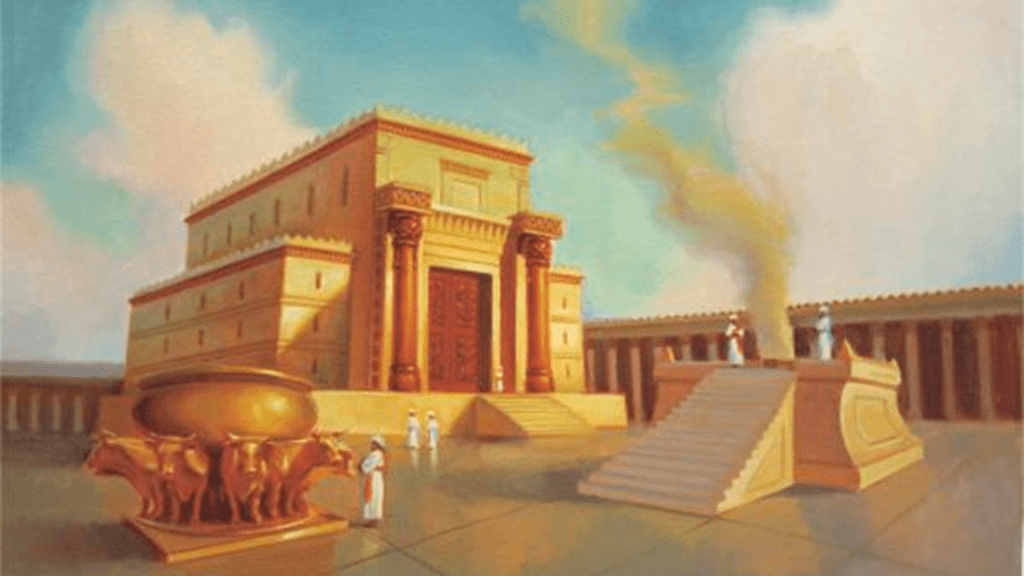
Early saints believed that both Freemasonry and the temple endowment came from ancient temple rituals. Hugh Nibley, Stephen Ricks, Matthew Brown, and Jeffrey Bradshaw have done work showing ties between what is done in modern temples and ancient temples[40]. As for the ancient origin of masonry, Greg Kearney simply states that many symbols within masonry predate Freemasonry.[41] Our modern temples match the theme of ancient temples symbolically moving man from his fallen state back into the presence of God. While this is not the purpose of Masonic rituals, it is possible that some aspects of the Masonic rites were fashioned after some ancient temple themes. There is still much disagreement on the source of Masonic rituals and whether they are ancient or relatively modern. Many historians today believe the rituals were created in the seventeenth century, but, there is clearly a biblical influence. One would expect that influence as early masons were devout practicing Christians surround by a devoutly Christian culture.
Let me summarize using a question and answer format.
Q. Did Joseph simply copy the temple ceremony from the masons?
A. No. There is too much in the temple that isn’t related to what goes on in masonry.
Q. Are there elements in the endowment ceremony that are found in masonry?
A.Yes. There are a few but they have been completely repurposed. Certainly the temple ceremony contains some of the phrases, wording, and symbols that exist within masonry. But, these things, both masonic and biblical, were part of the world Joseph Smith lived in. Just as we use movie language in our speaking, it is not surprising to have some masonic language in the world of Joseph Smith.
Q. Does freemasonry go back to the time of King Solomon, or is a modern creation?
A. We don’t know and we have no way of knowing. While members of the Church like the idea of masonry from the ancient temple, and it is what early church members believed and taught, current thought leans toward a more modern origin of freemasonry. Never-the-less, even if there was a more modern origin, masonry includes biblical temple themes and ancient symbols.
Q. Did Joseph Smith copy those similar elements from modern freemasonry, or do they stem from Solomon’s temple and other ancient temples?
A. We don’t know, and we have no way of knowing.
Q. Did Joseph Smith simply believe something was ancient that was really modern and copy that into a fake temple ceremony?
A. No, even if you stripped out all of the elements that overlap with masonry, the temple ceremony is surprisingly in alignment with ancient temples.
The Lord wanted to give us a gift or endowment. He directed Joseph Smith to create a ceremony where we would make covenants with God and receive promised blessings. The teachings, covenants, and promises within that temple ceremony do not come from masonry.
Even if we were to take the position that Joseph Smith took the revealed covenants and designed a ceremony himself to remind us of those covenants on a regular basis, Joseph Smith would still be a prophet acting within his calling. We take the sacrament each week to symbolically reenact the last supper while we make covenants. In the temple, we are symbolically reminded of our purpose in life and how we should follow God. I know that theme comes from God and is ancient in origin.
In conclusion, Masonry focuses on man’s relationship to man while the temple endowment focuses on man’s relationship to God. While there may be some passing similarities between some Masonic rituals and the temple ritual of the endowment, the teachings, the covenants, and the purposes are completely different.
Did Joseph Smith use some words and symbols from Masonry to create the temple ceremony? Probably, but only a very small amount that he repurposed for a different meaning.
Did the Masons use words and symbols from Solomon’s temple to create their masonic ceremonies?
Or were they purely seventeenth century creations? I don’t think anybody knows that answer for sure. But, it really doesn’t matter. Because the claim Joseph Smith borrowed the endowment ceremony from masonry, whether created in the seventeenth century or not, is clearly false.
While there are a few similarities, the entire purpose and intent is different. Instead of believing that Joseph Smith copied the ceremony from the Masons, it makes much more sense to say that the Joseph Smith received the promises and covenants of the Temple from God and from the scriptures. But he also adapted and repurposed some things he was exposed to in Freemasonry to assist in that temple ceremony. Whether those few repurposed masonic elements are of ancient or modern origin, I will leave up to you.
I have personally witnessed the influence and miracles of God within the walls of the temple and the power that keeping the covenants that we make there has had in my life. The temple creates a sacred space for us to worship God. As we participate in temple ordinances we set ourselves on the path to return to Him blessing our own lives and the lives of our families.

Q&A
Q1: Does D&C 95:8 Kirtland 1833 “…build a house in the which house I design to endow those whom I have chosen with power from on high.” Does this verse not show that the temple ceremony is from the Lord?
A1: I believe the temple ceremony is from the Lord. I believe that. How much? How much came from the culture, Joseph Smith, or from Masonry or whatever I don’t know, but as far if you were to ask me does the temple ceremony come from the Lord I’d say, “Yes.” Is it designed exactly like the Lord put it there? I don’t know. I don’t know that. It could be like the brother of Jared in lighting the boat. I’m not sure and so I don’t have to take a position on that either way. But as far as temple ceremony endowment, is it from God? Absolutely it is.
Q2: Did Masonry play a role in the Kirtland bank collapse?
A2: That’s a great question. I think you should ask that of Elizabeth Kuehn.
Q3: Do we know Freemasonry being accepted by Joseph Smith Jr. contributed to W.W. Phelps’ apostasy from the early church?
A3: I don’t believe it did. Is it possible? It’s hard for us in hindsight to read the minds of people, but I think W.W. Phelps and all of the Masons within the church stayed faithful. Brigham Young tried to reestablish Masonry when he moved here to Utah. He contacted the Mexican Grand Lodge first and they turned him down, because of plural marriage that did not fall within the standards of Masonry. At least I believe that’s the reason they did. And then he also claimed he sent a letter to another Grand Lodge and but there’s no record of that Grand Lodge ever receiving that letter. I don’t know why. So he tried to continue Masonry even after they moved to Utah.
Q4: Do we know how high in Freemasonry Joseph Smith rose in its ranks?
A4: Well he was a Master Mason in the Blue Lodge, which is the…it’s not one of the optional rites, but it’s being a Master Mason. I know we have at least one Master Mason in our crowd here. [Speaking to a member of the audience] Yes, would you say that’s the highest?
[Member of the audience] Every degree above the third degree is still a Master Mason.
[Scott] Ok.
[Member of the audience] Although [in] the independent body, [in] both the York Rite, of which I am member, and the Scottish Rite, you are still a Master Mason even if you work your way through all of those degrees.
[Scott] Right.
[Member of the audience] I don’t believe York Rite or Scottish Rite were available in Illinois at the time Joseph… [indistinguishable]
[Scott] And I don’t either, Yes.
[Scott] Right. There is York Rite and Scottish Rite. People argue was it available/was it not available? I see no evidence it was available. Could it have been? If somebody says, “Here it was.” Then I’d say like, “Ok, maybe it was.” But we have no record of that. We have no record Joseph Smith was involved with it.
Q5: Do you think that Masonry was the energy behind the Crusades to fight Islam?
A5: That’s one of the theories, but I don’t know.
Q6: Are you aware of an ancient Chinese creation myth where the creative beings used the compass and the square as creative tools, predating Solomon?
A6: That’s over my head. You’ll have to ask somebody who’s more familiar with that. That’s interesting.
Q7: You mention the Masonic ceremonies have elements that are similar to the temple. Wouldn’t it be correct to say that some of the ritual actions involved in the two ceremonies are identical?
A7: Yes. That would be correct to say that some of the ritual actions involved in the two ceremonies are identical. But, again, they’re repurposed, so they have different meaning. It’s like if you sign a contract for your car or you sign a job contract, [in] both cases you’re signing a contract, but they’re different things. One’s for a car, one’s for a job. So they’re just different things. There’s a few actions.
Footnotes
[1] Kearney, Greg https://www.fairmormon.org/conference/august-2005/the-message-and-the-messenger-latter-day-saints-and-freemasonry, accessed 7/7/2017.
[2] http://www.masonicsourcebook.com/stonemasons_operative_masons.htm, accessed 7/31/2017
[3] http://www.grandlodgescotland.com/masonic-subjects/masonic-articles/381-operative-and-speculative-masonry-the-guilds-and-livery-companies Accessed 7/7/2017. There exists numerous other sources on the start of the Grand Lodge.
[4] Robinson, John J. (1990-10-25). Born in Blood: The Lost Secrets of Freemasonry . M. Evans & Company. Kindle Edition. p. 175
[5] http://www.ugle.org.uk/what-is-Freemasonry Accessed 4/26/2015
[6] Jacob, Margaret C, The Origins of Freemasonry, University of Pennsylvania Press, 2007 p. 72
[7] Jacob, Margaret C, The Origins of Freemasonry, University of Pennsylvania Press, 2007 p. 15
[8] J. Smith, Jr., Scriptural Teachings of the Prophet Joseph Smith, 19 December 1841, Book first published 1938 p. 329.
[9] Benimeli, Josè A Ferrer, “Freemasonry and the Catholic Church”, Handbook of Freemasonry, Brill 2014 p. 151.
[10] Ibid.
[11] Ibid.
[12] Robinson, John J. (1990-10-25). Born in Blood: The Lost Secrets of Freemasonry. M. Evans & Company. Kindle Edition. P. 183.
[13] Bodgan, Henrik and Jan Snoek, Handbook of Freemasonry, Brill 2014 p. 26.
[14] Many Latter-day Saints can relate to the idea of a splinter group whose behavior tarnishes the main group even though they threw them out or excommunicated them.
[15] Introvigene, Massimo “Freemasonry and the New Religious Movements”, Handbook of Freemasonry, Brill 2014 p. 312.
[16] Bodgan, Henrik and Jan Snoek, Handbook of Freemasonry, Brill 2014 p. 28, 214-215.
[17] https://www.ushmm.org/wlc/en/article.php?ModuleId=10007058 accessed 7/31/17 and https://www.adl.org/education/resources/backgrounders/a-hoax-of-hate-the-protocols-of-the-learned-elders-of-zion accessed 7/31/17.
[18] Jacob, Margaret, The Origins of Freemasonry, University of Pennsylvania Press, p. 7.
[19] Jacob, Margaret, The Origins of Freemasonry, University of Pennsylvania Press, p. 8.
[20] Bessel, Paul M. The Anti-Masonic Party, http://web.mit.edu/dryfoo/Masons/Essays/anti-Masonic.html, accessed July 11, 2017.
[21] http://www.josephsmithpapers.org/person/william-wines-phelps, accessed July 11, 2017.
[22] Ibid.
[23] Lucinda Morgan Harris is the person whom Elizabeth Marsh, wife of Thomas B. Marsh, allegedly got into a dispute with over a pint of milk strippings. While it has been claimed there was no support for the milk strippings story, a second look at historical documents has found references that lend support for the event. The event is admittedly complicated. http://juvenileinstructor.org/thomas-b-marshs-reconciliation-with-george-w-harris/
[24]Woodruff, Wilford, journal quoted in “Journal of Mormon History Vol. 18, No. 2, 1992,” at:http://digitalcommons.usu.edu/mormonhistory/vol18/iss2/1.
[25] https://rsc.byu.edu/archived/selections-2006-religious-education-student-symposium/masonic-martyrdom-freemason Accessed July 7, 2017.
[26] “The Golden Bible”. 1831 The Geauga Gazette. Painseville, Ohio, March 15, 1831:1.
[27] https://www.lds.org/scriptures/gs/secret-combinations?lang=eng
[28] https://www.lds.org/general-conference/1997/10/standing-for-truth-and-right?lang=eng
[29] Lucius N. Scovil[le], Letter to the Editor dated February 2, 1884 as quoted in Homer, Michael W Joseph’s Temples, University of Utah Press, 2014 p. 205.
[30] L. John Nuttall, Diary, February 7 1877, Special Collections, Lee Library.
[31] Godfrey, Kenneth W http://eom.byu.edu/index.php/Freemasonry_and_the_Temple accessed July 5, 2017.
[32] Brigham Young tried to start a lodge in Utah after he got there, but was unable to get a charter. Later, non-Mormons started the lodge and refused to admit Mormons. This violated Masonic rules, but persisted anyway for many years.
[33] Mrs. T. B. H. Fanny” Stenhouse, “Tell it All”: The story of a Life’s Experience in Mormonism. Hartford, CT: A. D. Worthington & Co., 1874 p. 354.
[34] Conversation with Greg Kearny on July 5, 2017.
[35] Introvigene, Massimo Freemasonry and the New Religious Movements, Handbook of Freemasonry, Brill 2014 p. 312.
[36] Brigham Young, Journal of Discourses 9:311. [13 July 1862]
[37] Introvigene, Massimo Freemasonry and the New Religious Movements, Handbook of Freemasonry, Brill 2014
[38] The blue lodge is a sort of short hand so named for the color of the covers of the ritual code books. The term blue lodge refers to lodges working the three degrees.
[39] Mackey, Encyclopaedia of Freemasonry, 1:327. And “Masonic,” Norwalk (Ohio) Reporter and Huron Advertiser, February 9, 1828.
[40] See http://www.mormoninterpreter.com/jeffrey-m-bradshaw-on-what-did-joseph-smith-know-about-temple-ordinances-by-1836/ and the books Temple Themes in the Book of Moses, by Jeffrey M. Bradshaw, Hugh Nibley Temple and the Cosmos, by Hugh Nibley, and Exploring the Connection Between Mormons and Masons, by Matt Brown.
[41] Conversation with Greg Kearney on July 5, 2017.
